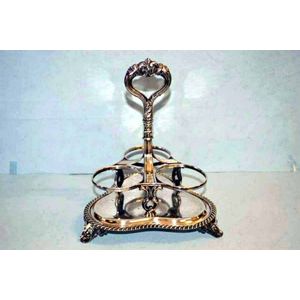Antique Sheffield Tantalus Carriage with Bell Mark
You must be a subscriber, and be logged in to view price and dealer details.
Subscribe Now to view actual auction price for this item
When you subscribe, you have the option of setting the currency in which to display prices to $Au, $US, $NZ or Stg.
- Tantalus - A tantalus is a container for holding two or three glass or crystal bottles of alchoholic drinks. A tantalus may take various forms, the most common being made from silver, silver plate or wood with the three bottles in a circle or two bottles in line with a central handle. A larger version has three bottles in a line with two end supports and a horizontal top and handle. To prevent unauthorised access, some tantalus have a locking mecahnism that prevents the bottles and stoppers being removed from the bottles when secured.
A box tantalus, as the name implies is an elaborate wooden box made of a fancy timber such as coramandel, with divisions for the bottles and a lockable lid. Some of these type are designed for liquers and include the liquer glasses set into fitted holders. - Georgian - As an English stylistic period, Georgian is usually taken to cover the period from George I (1714) to the Regency of Prince George (1811-20), although the period from 1800 to 1830 is sometimes designated as the Regency period. During the Georgian period the great English cabinetmakers and designers such as Chippendale, Hepplewhite, Adam Sheraton etc., were all active.
Therefore there isn't a single 'Georgian style' as such and to say something is 'Georgian', usually means it was made between 1714 and 1830. This assumes we discount George V and George VI, both being from the 20th century.
The styles popular at the time of each reign were:
George I (1714-1727) saw out the last years of the Baroque period.
George II (1727-1760) reigned during the Rococo period.
George III (1760-1820) saw the last gasp of the Rococo, all of the early Neo-Classic 'Adam style' and most of the later neo-Classic 'Regency style'.
George IV (Prince Regent 1820-1830)encompassed the last of the 'Regency' style.
William IV's reign (1830-1837) was something of a no man's land (stylistically) and he wasn't a 'George' anyway. He covered the last glimmerings of 'Regency' and the start of the 'Victorian' style.
This item has been included into following indexes:
Visually similar items

A Tibetan gilt bronze vajar, 18th century, The thunderbolt-sceptre is cast with a central bulbous grip that separates two lotus pedestals supporting a central column surrounded by eight arched vajra points emerging from the jaws of makara heads, 17 cm long

A Georg Jensen Moonlight Grapes brooch. Sterling silver, marked post 1945 925 S Denmark style no 217A by Harald Nielsen from the Moonlight Grapes series, featuring two unfurled grape leaves of convex form, suspending a central grape bunch of articulated bu

Victorian 9ct gold cross, engraved at each point, set with garnets and pearls, weight: approx 3.73 grams, size: approx 5 cm length including bale

A large and rare parcel-gilt meteorite iron Tibetan phurba, probably 16th/17th century, very well handwrought, with articulated prongs on the vajra and with silver inlay, the top with a three-headed wrathful deity, a three-dimensional Makara on the blade.
